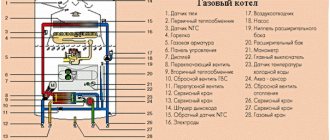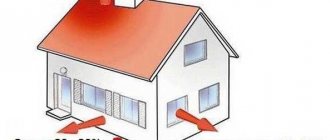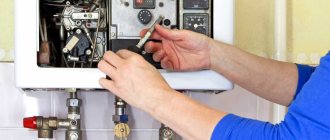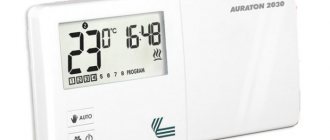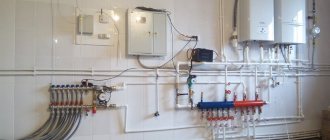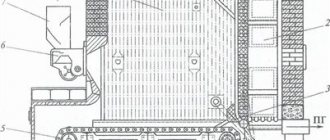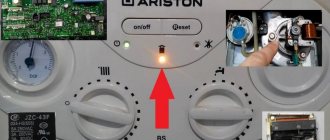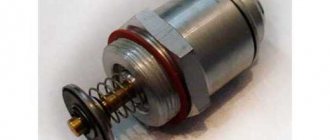Here you will learn:
- What does boiler efficiency depend on?
- How to calculate the efficiency of a heating boiler
- Reasons for reducing the efficiency of heating boilers
- How to increase the efficiency of a gas boiler
- Installing radiators for maximum efficiency
- What should an energy efficient boiler be like?
- Which gas boiler has the highest efficiency?
In order to define the concept of an economical gas boiler, it is necessary to clarify that such a boiler will heat the room at minimal cost. This is a boiler that is correctly calculated in terms of power in accordance with the heating area, with high efficiency, with good regulation of operating modes, and with optimal gas consumption. If we generally define the criteria for boiler efficiency, then we should pay attention to the following:
- Optimally suitable power;
- High efficiency;
- Optimal design and additional equipment;
- Reliable, well-established manufacturer.
Let's consider these and other criteria that affect the efficiency of the boiler. In details.
What does boiler efficiency depend on?
The efficiency factor is a percentage of the calorific value of the fuel. In other words, the efficiency indicates what part of the heat of combustion of the fuel the boiler can use for heating. In this case, any calculations are based on the properties of natural gas, which corresponds to accepted state standards.
Equipment performance depends on several main factors:
- burner type - closed models demonstrate higher efficiency than atmospheric ones;
- heat exchanger design – the maximum amount of energy is transferred to the coolant by wall-mounted and floor-mounted condensation models;
- control system - sensors, automatic solutions, built-in or separately mounted pump guarantee rational use of fuel;
- type of ignition - with an electric ignition device there is no need to install a constantly operating igniter, which saves resources;
- third-party factors - correct installation, chimney design, etc.
The most energy-efficient boilers are classified as expensive, but the costs of their purchase and installation are more than recouped due to minimal fuel consumption and long service life.
Rule of successful statistics
What is the point of bringing a tank onto the field? Of course, the goal is to remain in a combat-ready state for as long as possible and at the same time accomplish something useful, for example, inflict incredible damage, illuminate enemy tanks, prevent the capture of a base, and so on.
You should not immediately merge, even if your nickname is at the end of the list. You need to be patient and wait. As soon as it becomes clear what positions the tanks occupy, you can begin to plan your actions.
It also happens that players on a team merge, and you have to be left alone with enemy vehicles. Just don’t give up right away, even if it seems like you can’t handle it, continue the game. Sometimes such tactics help to increase the number of unfinished tanks and recapture HP.
How to calculate the efficiency of a heating boiler
Values can be calculated in several ways. In European countries, it is customary to calculate the efficiency of a heating boiler based on the temperature of the exhaust gases (direct balance method), that is, knowing the difference between the ambient temperature and the actual temperature of the gases exiting through the chimney. The formula is quite simple:
ηbr = (Qir/Q1) 100%, where
- ηbr (read “this”) – boiler efficiency “gross”;
- Qir(MJ/kg) – the total amount of heat released during fuel combustion;
- Q1 (MJ/kg) – the amount of heat that was accumulated, i.e. used for heating the house.
For example, if Q1 = 22 MJ/kg, Qir = 19 MJ/kg, then gross efficiency = (19/22)*100 = 86.3%. All measurements are carried out at an already established, standard boiler operating mode.
The direct balance method does not take into account the heat loss of the boiler itself, underburning of fuel, deviations in operation and other features, so a fundamentally different, more accurate calculation method was invented - the “reverse balance method”. The equation used is:
ηbr = 100 – (q2 + q3 + q4 + q5 + q6), where
- q2 – heat loss with exhaust gases;
- q3 – heat loss due to chemical underburning of combustible gases (applicable to gas boilers);
- q4 – loss of thermal energy with mechanical underburning;
- q5 – heat loss from external cooling (through the heat exchanger and housing);
- q6 – heat loss with physical heat of slag removed from the furnace.
Net efficiency of the heating boiler according to the reverse balance method:
ηnet = ηbr - Qs.n, where
- Qс.н – total consumption of thermal and electrical energy for own needs in % expression.
The actual efficiency will almost always differ from that declared by the manufacturer, since it depends on the correct installation of the boiler and heating system, smoke removal system, quality of power supply, etc. It is measured, accordingly, already on the spot.
How to take into account the height of ceilings when calculating?
The formula below is suitable when the ceilings in the house are of standard height.
Those. do not exceed 2.6 - 3 meters. If the ceilings are higher, calculation by area will not work.
You need to use volume.
Knowing the volume of the room, you can calculate the predicted heat loss (HL) using the formula:
PT = V (volume) x Pt (difference t) x k: 860.
Pt – difference in average temperatures outside and indoors. Example: in winter the average temperature is -30 C, but in the house you want it to be 22 C. Pt = 52. The higher this indicator is, the more the building will lose heat.
k is the dispersion coefficient. It depends on the building materials from which the structure is made:
- Wood or corrugated iron, no insulation = 3–4.
- Single brickwork, regular windows and roof, average thermal insulation = 2 – 2.9.
- Double brickwork, good thermal insulation, few windows = 1 – 1.9.
- Excellent thermal insulation, plastic windows, well insulated floor and ceiling = 0.6 - 0.9.
Now that all the basic data is known, you can calculate the boiler power using the formula:
M = PT x kz.
Kz in these calculations is the safety factor. It is equal to 1.15 - 1.2 (that is, 15 - 20%)
Example. Brick house with good thermal insulation, area 60 m2. And the ceiling height is 3m.
- Let's calculate the volume. 60m2 x 3 = 180m3. Pt = 52, k = 1.5.
- We substitute the data into the formula: PT = 180 x 52 x 1.5: 860. PT = 16.32.
- We multiply this indicator by the safety factor: 16.32 x 1.2 = 19.58.
- We round up and get a boiler with a capacity of 20 kW.
Reasons for reducing the efficiency of heating boilers
Even before increasing the efficiency of the heating battery, you need to decide on this parameter. In fact, it consists of several components - the efficiency of the boiler, radiators and pipelines. But besides this, you need to take into account the amount of heat loss of the building.
Therefore, you should first not think about how to increase the efficiency of the heating battery, but improve the thermal insulation of the house. Only by reducing losses through walls and windows can you begin to modernize your heating. It is mistakenly believed that the main indicator of the system is the efficiency of gas heating boilers or their solid fuel analogues. However, the actual beneficial effect of the system is determined by the following formula:
Q=Vinput/Vinput
Where Q is the efficiency indicator, Vinput is the amount of energy spent on heating the coolant, Vinput is the actual heat transfer to the air in the room.
When analyzing the operation of a boiler, especially a gas type, it is clear that it does not function all the time. It must maintain the heating level of the coolant at the set thermal mode. Other elements of the system - pipelines and radiators - are responsible for transmitting energy. It is they who first need to pay attention, since the efficiency of the heating system depends 80% on their proper functioning.
What needs to be done to ensure that this indicator is initially maximum:
- Select low temperature operating mode. With a minimal difference in water heating after the boiler and in the return pipe, energy costs will decrease;
- Use of electronic control systems - thermometers and programmers. They will allow you to automatically change the operation of the boiler when the temperature in the house and outside changes;
- Upgrade elements to achieve maximum heating efficiency in the house.
All these methods are interconnected with each other. Therefore, when organizing heating, you need to approach each stage professionally.
During the design of the system, it is necessary to calculate its main parameters - heat losses, the operation of each node and the optimal temperature regime. This can be done using online calculators (high error) or by ordering a service from specialized settlement bureaus (accurate data).
Types of heat loss
Having understood what efficiency is in heating boilers, it is necessary to analyze the reasons that prevent you from achieving maximum efficiency from the equipment.
- Mechanical underburning - to maintain the combustion process, fresh air must be supplied to the burner. For this purpose, the boiler is equipped with a miniature door - a vent. If this window is open too much, a draft will form inside the chamber, drawing some of the unburnt gas into the chimney. In this case, the efficiency drops by several percent.
- Chemical underburning - if there is a lack of oxygen, the gas also does not burn completely, so it is sent up the chimney. In this case, the efficiency can decrease by 7%.
- General heat loss - lack of proper thermal insulation of the roof steals 10-25% of efficiency. Walls that conduct heat well take 20-30% of the boiler's power. Old windows and doors deprive you of 15-25% of heating. Flooring on the ground reduces heating efficiency by 3-6%, and improper arrangement of the ventilation system removes 30-40% of heat from the room.
How much is this in money
To understand how much this costs, let’s determine the heat losses of the building through the walls and calculate how much gas is needed to compensate for them.
At an outdoor temperature of 0°C and an internal temperature of +22°C, heat loss per 1m2 of wall will be 7.85 W/h. We will also need such values as the duration of the heating period - 150 days, wind speed - 3 m/s and gas price - 6.98 UAH/m3.
| Option A | Option B | |
| External wall area, m2 | 162 | 216 |
| Daily heat loss, kW | 24,53 | 32,71 |
| Annual heat loss, kW | 3 680 | 4 906 |
| Gas consumption, m3/year | 528,7 | 704,9 |
| Annual costs, UAH | 3690 | 4 920 |
| Overpayment for heating, UAH/year | 1 230 |
By changing the shape of the building, its potential heat loss was reduced by 1227 kWh/year, which at a gas tariff of 6.98 UAH/m3 will be 1230 UAH/year. On the one hand, this is not much, but on the other hand, it does not require any additional costs.
In addition, the following must be taken into account:
- Energy resources are constantly becoming more expensive, and savings will only increase every year.
- The worse the thermal insulation qualities of the wall material, the greater the savings will be. For a wall made of shell rock it will be 3,169 UAH/year, for hollow brick - 4,036 UAH/year, foam concrete - 2,885 UAH/year.
- The calculations used an average street temperature of 0° C, but the colder it is outside, the greater the heat loss. For the example above, at a street temperature of -10 °C (instead of 0 °C), the overpayment for heating will be already 50% higher - 1789 UAH/year.
- Every corner in the building is a bridge of cold. A square-shaped house has four corners, while an L-shaped house has six. That is, in the second case you get two additional cold bridges (which will also increase heat loss by 5-15%). If the building has an even more complex shape, then there will be more angles.
- If you decide to insulate the house, then in the second case the insulation area will be 54 m2 larger. If the price of foam insulation is 400 UAH/m2, the overpayment will be 21,600 UAH.
- Calculations were made for gas heating. When using alternative heat sources, heating costs will be different.
How to increase the efficiency of a gas boiler
You can create suitable conditions for increasing efficiency by optimizing processes yourself or with the involvement of a specialist. Initially, all parameters are included in the design of the electric boiler; the effectiveness of measures taken to increase the efficiency of the equipment will depend on these data.
To begin with, modernization is carried out without changing the structure of solid fuel boilers:
- Room thermostats. They control the temperature in living spaces without affecting the operation of the coolant.
- Installing a circular pump, this way you can stabilize the uniformity and speed of heating.
- Replacing a gas burner will increase the efficiency of a solid fuel boiler by 5-7%. A modulating burner will allow you to consume the gas-air mixture in the correct proportions, which will eliminate incomplete combustion.
- The location of the burners near the water circuit will add several percent to the total efficiency. Such a partial modification will have a positive effect on fuel consumption and increase the thermal balance of the entire system.
Carrying out regular maintenance and cleaning of equipment will increase its efficiency. Scale in the pipes of the heating system and soot on the outer walls of the chimney, formed during operation, can take up to 5%. Plastic pipes require less maintenance, but they must be purged periodically.
A clogged chimney narrows the passage of the smoke exhaust pipe, this leads to a decrease in draft, and this is not only a loss of heat, but also a threat to the health of people in residential premises.
Also, a heat exchanger with visible signs of contamination, which are salt deposits of metals, provokes a high consumption of all types of energy spent on work, which reduces thermal conductivity and can damage the boiler. Cleaning the combustion chamber is mandatory and is carried out several times a year.
As an option to reduce chemical heat losses, a highly qualified equipment system is configured for this. It is better to refrain from setting it up yourself and entrust the matter to a specialist.
The fight against underburning is solved by increasing the rate at which liquefied gas enters the burner, so the combustion process occurs more actively, and the efficiency, accordingly, increases.
Although an increase in efficiency has practically no effect on the thermal efficiency of the boiler unit. Today, natural gas remains the most economical; equipment using this fuel is more common and economically justified than boilers using traditional solid wood fuel or coal.
How to increase the efficiency of heating equipment running on solid fuels
Today, many consumers, having at their disposal a solid fuel boiler, are trying to find the most convenient and practical way to increase the efficiency of heating equipment. The technological parameters of heating devices set by the manufacturer lose their nominal values over time, so various methods and means are being sought to increase the efficiency of boiler equipment.
Let's consider one of the most effective options, installing an additional heat exchanger. The task of the new equipment is to remove thermal energy from volatile combustion products.
In the video you can see how to make your own economizer (heat exchanger)
To do this, we first need to know what the temperature of the smoke at the outlet is. You can change it using a multimeter, which is placed directly in the middle of the chimney. Data on how much additional heat can be obtained from evaporating combustion products is necessary to calculate the area of the additional heat exchanger. We do the following:
- we send a certain amount of firewood into the firebox;
- We measure how long it takes for a certain amount of firewood to burn.
For example: firewood, in the amount of 14.2 kg. burn for 3.5 hours. The smoke temperature at the boiler outlet is 460 0 C.
In 1 hour we burned: 14.2/3.5 = 4.05 kg. firewood
To calculate the amount of smoke, we use the generally accepted value of 1 kg. firewood = 5.7 kg. flue gases. Next, we multiply the amount of wood burned in one hour by the amount of smoke produced by burning 1 kg. firewood As a result: 4.05 x 5.7 = 23.08 kg. volatile combustion products. This figure will become the starting point for subsequent calculations of the amount of thermal energy that can be additionally used to heat the second heat exchanger.
Knowing the value of the heat capacity of volatile hot gases as 1.1 kJ/kg, we make a further calculation of the heat flow power if we want to reduce the smoke temperature from 460 0 C to 160 degrees.
Q = 23.08 x 1.1 (460-160) = 8124 kJ thermal energy.
As a result, we obtain the exact value of the additional power provided by volatile combustion products: q = 8124/3600 = 2.25 kW, a large figure that can have a significant impact on increasing the efficiency of heating equipment. Knowing how much energy is wasted, the desire to equip the boiler with an additional heat exchanger is completely justified. Due to the influx of additional thermal energy for heating the coolant, not only the efficiency of the entire heating system increases, but also the efficiency of the heating unit itself increases.
Installing radiators for maximum efficiency
Radiators are installed in areas where heat loss in the room is most significant, for example, next to windows. To achieve maximum efficiency, the window sill should cover about 2/3 of the upper plane of the battery and be approximately 10 cm from its surface. The recommended distance between the radiator and the floor is 12 cm. The rear surface of the battery should be separated from the wall by 2 cm. This will create proper natural convection , in which a certain amount of heat is spent on heating the wall and blocking heat loss in the room, and most of the energy is directed to heating.
Safety measures for increasing efficiency
Just 20-30 years ago, the price of energy resources in the post-Soviet space was low, so no one paid attention to such a parameter as efficiency. After all, performance could decide everything. But when gas began to rise in price, and modern technologies were still unavailable, craftsmen began to modernize gas boilers in order to increase efficiency, using accessible methods.
When performing any work with gas equipment, it is necessary to observe safety measures and possess special skills and tools. And also you should not use methods prohibited by law to increase efficiency.
For example, attaching copper and aluminum plates to heat exchangers to improve heat transfer. Heat loss from structural elements of heating devices was reduced by welding third-party elements. The automation and heat exchangers were changed. Other similar methods were also used. Efficiency increased, but the state and the gas service did not react to the “creativity” of the craftsmen.
Now everything is different and relevant laws prohibit changing the design of gas boilers, which must be certified, like all their individual elements. As a result, it is impossible to increase efficiency by replacing mechanical, electrical and other components of heating devices with third-party ones.
Violation of these requirements may result in:
- Administrative responsibility. If Gorgaz employees detect tampering with the boiler design, but there were no incidents, they will have to pay a fine of 10-15 thousand rubles. This is indicated by Article 7.19 of the Administrative Code. In severe cases, the gas service has the right to even terminate the service contract and stop supplying fuel.
- Criminal liability. As evidenced by Federal Law No. 229-FZ of July 29, 2018 “On amendments to Article 215.3 of the Criminal Code of the Russian Federation and Articles 150 and 151 of the Code of Criminal Procedure of the Russian Federation.” These standards will come into force if design changes lead to serious consequences.
That is, it’s not worth risking people’s lives to increase the efficiency of the boiler by a few percent.
Decorative lattice - master class
To make a screen for a niche radiator design, you need to take several steps:
Making a template in the form of a design you like from waste plywood. Going through the template with a jigsaw. It needs to be processed with a milling cutter
It is important to achieve ideal transitions between the details of the ornament. To close the niche with the battery you need to prepare several templates. Depending on the width of the niche, you should choose your number of fragments. They need to be sanded and coated with special enamel.
It is important to make special holes for fastening. After the enamel has completely dried, the parts are sanded and painted with the required shade of paint. The parts are secured using fasteners.
What should an energy efficient boiler be like?
The characteristics specified in the documents and rich practical experience show that imported boilers have the highest efficiency. European manufacturers pay special attention to the use of energy-saving technologies, which allows them to get the most out of their equipment. Let’s make a “portrait” of an ideal gas boiler:
- modulation burner - automatically adapts to the operating mode of the system, minimizing the percentage of underburning;
- heating the coolant no more than 70 degrees, exhaust gases - up to 110 degrees, which ensures an optimal balance of efficiency, it is desirable to have a condensation heat exchanger;
- coaxial chimney - a closed combustion chamber requires the equipment to have a pipe-in-pipe channel for removing combustion products, which allows heating the air flow from the street;
- recirculation system - allows you to use the heat of exhaust gases to heat the room.
Of course, such an ideal boiler does not exist, but a list of the best technical solutions will help you choose a worthy model.
Conclusions and useful video on the topic
The first video will help you understand how to clean the boiler heat exchanger, which will help to significantly increase its efficiency.
The following video will give you an opportunity to understand how to clean a gas burner in order to increase the efficiency of the boiler.
Experience shows that maximum efficiency from a boiler can be achieved with its systematic maintenance with timely cleaning of burners and heat exchanger from combustion products and dirt. And also with proper placement and use of radiators. In addition, only modern high-tech equipment can be highly efficient.
Have you noticed a discrepancy or want to supplement our material with useful recommendations for increasing the efficiency of the boiler? Leave your comments, participate in the discussion and ask your questions to our experts - the feedback form is located below.
Which gas boiler has the highest efficiency?
Statistics and technical documentation clearly indicate that imported boilers have the highest efficiency. European manufacturers place special emphasis on the use of energy-saving technologies. A foreign gas boiler has high efficiency, since some modifications have been made to its design:
- A modulating burner is used - modern boilers from leading manufacturers are equipped with smoothly two-stage or fully modulating burner devices. The advantage of the burners is their automatic adaptation to the actual operating parameters of the heating system. The percentage of underburning is reduced to a minimum.
- Heating the coolant - the optimal boiler is a unit that heats the coolant to a temperature of no more than 70°C, while the exhaust gases are heated to no more than 110°C, which ensures maximum heat transfer. But, with low-temperature heating of the coolant, several disadvantages are observed: insufficient traction force, increased condensation. Heat exchangers in gas boilers with the highest efficiency are made of stainless steel and equipped with a special condenser unit designed to extract heat from the condensate.
- Temperature of the supply gas and air entering the burner. Closed boilers are connected to a coaxial chimney. The air enters the combustion chamber through the outer cavity of the double-cavity pipe, preheated, which reduces the required heat input by several percent. Burners with preliminary preparation of the gas-air mixture also heat the gas before supplying it to the burner.
- Another popular modification option is the installation of an exhaust gas recirculation system, when the smoke does not immediately enter the combustion chamber, but passes through a broken chimney duct and, after mixing fresh air, returns to the burner device.
Maximum efficiency is achieved at the condensation temperature or “dew point”. Boilers operating under low-temperature heating conditions are called condensing boilers. They are distinguished by low gas consumption and high thermal efficiency, which is especially noticeable when connected to gas cylinder units and a gas holder.
Condensing boilers are offered by several European manufacturers, including:
- Viessmann.
- Buderus.
- Vaillant.
- Baxi.
- De Dietrich.
The technical documentation for condensing boilers states that the efficiency of the devices when connected to low-temperature heating systems is 108-109%.
What's next?
It must be said right away that there are a number of requirements for a gas boiler. For example, it is necessary to have a special exhaust gas outlet with a deflector on top. In addition, everything must be perfectly connected. In other words, it is prohibited at the legislative level to use heating systems operating on this type of fuel without the necessary checks and obtaining the appropriate documentation. Therefore, before installing a self-made gas boiler, you must definitely call a specialist who deals with the above.
The fact is that such equipment belongs to devices that have an increased danger. And for a self-made boiler, you must obtain permission for installation from a gas service. And she, in turn, needs to provide a certificate for the product, moreover, the original, not a copy or photo.
You need to understand that getting such paper is not easy, and most often it costs a large sum of money. In addition, a minimal deviation from all prescribed standards leads to a complete ban on the use of homemade installations. This is a strong argument in favor of the fact that making a gas boiler with your own hands can only be done by a person who has extensive experience in installing and servicing such units. This refers to the complete set and assembly of the system from individual components, each of which is manufactured in compliance with GOST, and the use of hand-made parts is reduced to a minimum and is permissible only in non-critical areas.
When all issues with the relevant services have been settled, the boiler can be installed. Unfortunately, there are rare cases when homeowners manage to do this without the approval of technical supervision authorities, which is a gross violation of the law and is fraught with unpredictable consequences.
Operating rules for boiler devices, compliance with which affects the efficiency value
Any type of heating unit has its own optimal load parameters, which should be as useful as possible from a technological and economic point of view. The operation process of solid fuel boilers is designed in such a way that most of the time the equipment operates in optimal mode. This operation can be ensured by following the rules of operation of heating equipment operating on solid fuel. In this case, you must adhere to and follow the following points:
- it is necessary to observe acceptable modes of blowing and exhaust operation;
- constant control over the intensity of combustion and completeness of fuel combustion;
- control the amount of entrainment and failure;
- assessment of the condition of surfaces heated during fuel combustion;
- regular boiler cleaning.
The listed points are the necessary minimum that must be adhered to during the operation of boiler equipment during the heating season. Compliance with simple and understandable rules will allow you to obtain the efficiency of an autonomous boiler stated in the characteristics.
We can say that every little thing, every element of the design of a heating device affects the value of the efficiency factor. A properly designed chimney and ventilation system ensure optimal air flow into the combustion chamber, which significantly affects the quality of combustion of the fuel product. Ventilation performance is assessed by the excess air coefficient. An excessive increase in the volume of incoming air leads to excessive fuel consumption. Heat leaves more intensely through the pipe along with combustion products. When the coefficient decreases, the operation of boilers deteriorates significantly, and there is a high probability of oxygen-limited zones appearing in the furnace. In this situation, soot begins to form and accumulate in large quantities in the firebox.
The intensity and quality of combustion in solid fuel boilers require constant monitoring. The combustion chamber must be loaded evenly, avoiding focal fires.
During combustion, it is important to prevent failure of the fuel resource, otherwise you will have to face significant mechanical losses (underburning) of fuel. If you do not control the position of the fuel in the firebox, large fragments of coal or firewood falling into the ash box can lead to unauthorized combustion of the remaining fuel mass products. Soot and resin accumulated on the surface of the heat exchanger reduce the degree of heating of the heat exchanger
As a result of all of the above violations of operating conditions, the useful volume of thermal energy required for the normal operation of the heating system decreases. As a result, we can talk about a sharp decrease in the efficiency of heating boilers
Soot and resin accumulated on the surface of the heat exchanger reduce the degree of heating of the heat exchanger. As a result of all of the above violations of operating conditions, the useful volume of thermal energy required for the normal operation of the heating system decreases. As a result, we can talk about a sharp decrease in the efficiency of heating boilers.
Save with Programmable Thermostats
Many modern boilers support the ability to connect thermostats. You can place the thermostat in the room that can be used as a reference room. (Just never install thermostats in the kitchen. Due to the operation of the stove, it is always warmer there) Using the reference room, you set the temperature and the boiler already starts working from the thermostat signal. Practice shows that this method does little to make gas heating more economical.
In addition to simple thermostats, there are so-called programmable ones. They can be wired, wireless, powered or battery-powered. Options start from 2000 rubles and go on to infinity. Such thermostats allow you to set weekly operating modes.
How does this work in practice? Let's say you are a working person. And your whole family is often away from home. Study, work, etc. In fact, in your absence there is no need to heat the house to a comfortable temperature. It is enough just to maintain an adequate positive mode so that furniture, decoration and other parts of your home do not suffer. With a programmable thermostat, you can set the temperature by the hour.
Let's say you all leave for work at 9 o'clock and return home at 6 o'clock. You set the thermostat to lower the temperature from 9 am and raise it from 5 pm so that the house is already warm when you arrive.
In fact, in your absence, the heating will operate in economical mode. Savings in such scenarios can reach up to 30%.
We talked about this in more detail in the video:
There are a great variety of programmable thermostats. There are even some that can be controlled remotely from a smartphone. Here you can choose everything to your taste and color. The main thing is that they can all change their temperature depending on the time and day of the week.
The only important thing is that your boiler has the ability to connect thermostats. If you are using a simple boiler, then most likely there may not be such an opportunity.
All modern wall-mounted boilers support the connection of thermostats. This also applies to many floor-standing boilers.
Here is such a simple and uncomplicated way to make your gas heating more economical.
Choosing a torch for soldering
Soldering or cutting cannot be done using ordinary gas torches. For this purpose, powerful and productive devices are needed, equipped with an air blower or an injector. By adjusting the composition of the supplied mixture, you can achieve the flame of the required strength and perform the necessary work related to soldering metals or other materials. Professional torches used for soldering are expensive, and therefore they are needed by a narrow circle of specialists. The power of such devices is 10-15 kW.
Attention! This material is the subjective opinion of the authors of the project and is not a guide to purchase
Heat exchange within the system
The burning gas heats a container of water (coolant), which in turn heats the radiators. The latter affects the efficiency of the boiler only by how quickly and without loss the energy is transferred to the coolant. The most successful form of heat exchanger for this is a cylindrical one, inside of which the same burner is located. The coolant moves around them in a spiral, guaranteed to have time to heat up to the required temperature.
The heat exchanger material varies - from steel to cast iron and depends on the boiler model, each of which is calculated differently.
The operating principle of a condensing boiler is shown in the video below:
Incorrect air supply
The work of the flame greatly depends on how much oxygen enters the firebox. In order for fuel to burn normally and give off the maximum amount of heat, it needs a strictly defined amount of air - no more, no less. If there is not enough air, the hydrocarbons released during combustion will be poorly oxidized, which means less heat will be released. If a lot of air comes in, and it usually comes in cooled, the temperature of the released gases decreases and they do not have time to burn (again settling as soot on the pipes) and thereby release useful heat. It is worth noting that the air contains moisture, the evaporation of which also wastes heat (instead of heating the house).
Most solid fuel boilers offered on the market operate on the following principle. They have a thermostat installed that regulates the temperature of the water circulating through the heating system of the house to warm it. If the water becomes too hot, the thermostat reduces the air supply to the boiler (this is how the power of a solid fuel boiler is regulated). It turns out that at the moment when the fuel flared up and the efficiency with the power of the solid fuel boiler became maximum, which means the flame began to need more oxygen, the thermostat artificially reduces the efficiency, limiting the air supply.
After the temperature has dropped, the thermostat starts supplying air again. But by that time the fuel is already burning down and it doesn’t need as much oxygen. The heating efficiency is again reduced due to the cooling of the released gases, as mentioned earlier.
It turns out that the operating principle of most solid fuel boilers absolutely contradicts the concept of high efficiency.
Equipment setup
The open chamber is a fairly simple combustion device. It looks like this: above the burner there is a heat exchanger in the form of a coil of thin copper tubes. Thanks to the open design, the air required for the combustion reaction is supplied to the point of ignition of the gas from the environment.
As a rule, there is enough air from the room (provided good ventilation is organized). But there are wall-mounted models with air intake from outside, for which a special hole is mounted in the wall. Open combustion chambers require a chimney.
Most often it is installed for models of floor-standing gas boilers, and was also used to complete an old-style boiler (in this case, ignition was carried out by a pilot burner).
Combustion chamber design diagrams
Floor-standing gas boilers with an atmospheric burner can be configured independently. Pressurized systems are regulated by an automatic control unit and do not require additional configuration.
Scheme of actions for setting up single-stage equipment:
- Install the device on the boiler.
- Connect to the gas pipe.
- Check for absolute tightness.
- Remove the burner housing.
- Using a pressure gauge, measure the gas pressure at the inlet.
- Connect to electricity. Make sure that the jumpers and phases are connected correctly.
- Place a gas analyzer in the chimney pipe.
- Start the device.
- Using a pressure gauge, take pressure readings at the outlet of the burner block. Pressure readings must correspond to the parameters indicated in the data sheet.
- Adjust the air flow using the air damper.
- The gas analyzer readings must also comply with all gas equipment installation standards.
Setting up gas equipment should be carried out by specialists. The simplest open-type boilers can be configured independently if you have certain skills and knowledge of the design of the burner unit. The efficiency of the boiler, its level of efficiency, and fuel consumption depend on the quality of the burner. It is possible to superficially determine that the equipment is malfunctioning by the changed burner flame.
